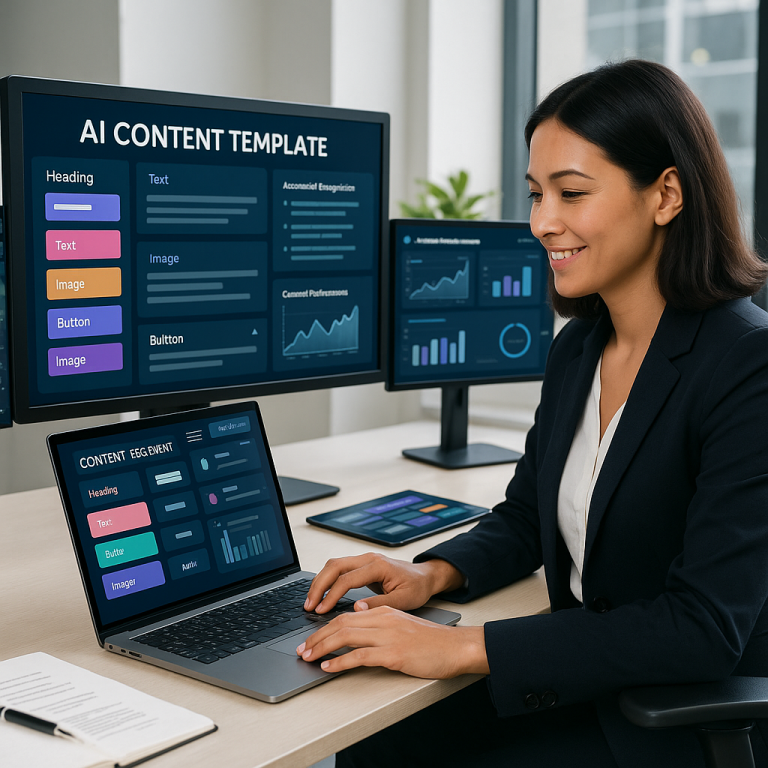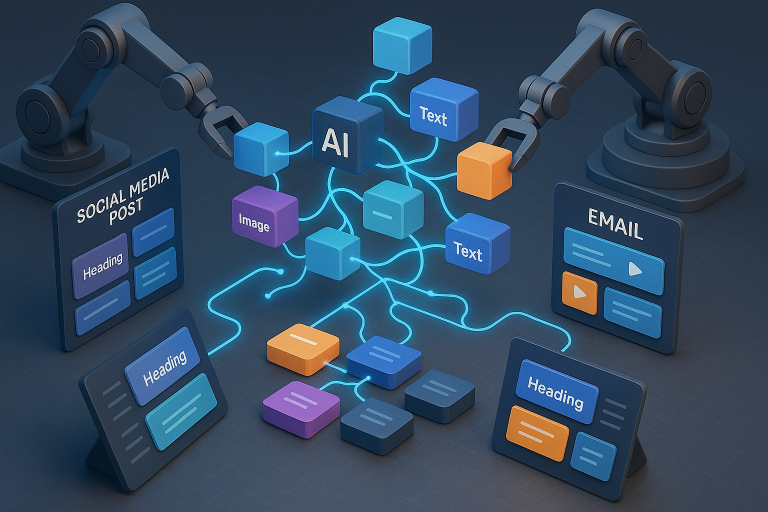Transform Your Content Strategy with AI-Driven Templates
In today’s fast-paced digital landscape, content creation has become both more important and more demanding than ever. Marketing teams, product developers, and communication professionals face mounting pressure to produce high-quality, engaging content at increasing volumes—all while maintaining brand consistency and personalized messaging. This is where AI-driven content templates enter the picture, revolutionizing how organizations approach content creation.
Whether you’re struggling with content bottlenecks, inconsistent messaging, or simply looking to scale your content operations, AI-powered templates offer a promising solution. Let’s explore how these intelligent systems are transforming content strategies across industries and how your team can leverage them for maximum impact.

Understanding AI-Driven Content Templates
Before diving into implementation strategies, let’s establish what exactly makes AI-driven content templates different from their traditional counterparts—and why this evolution matters for your content operations.
The Evolution from Static to Smart Templates
Content templates have been around for decades, helping organizations maintain consistency and save time. However, traditional templates have always been fundamentally static tools—unchanging frameworks that require human intelligence to adapt and populate.
The journey from conventional templates to today’s AI-driven solutions reflects a significant technological leap:
- First generation (1990s-2000s): Basic word processor templates with fixed placeholders and formatting
- Second generation (2000s-2010s): Dynamic templates with variables and conditional logic
- Third generation (2010s-present): AI-enhanced templates that learn, adapt, and generate content autonomously
Unlike their predecessors, AI-driven content templates don’t just provide structure—they actively participate in the content creation process. They learn from existing content, recognize patterns, and generate new content that matches your brand voice while adapting to different contexts.
Core Technologies Powering Smart Templates
The intelligence behind these systems comes from several sophisticated technologies working in concert:
Technology | Role in AI Templates | Business Impact |
Natural Language Processing (NLP) | Analyzes and understands text semantics, context, and structure | Enables templates to generate human-like, contextually appropriate content |
Machine Learning | Identifies patterns in existing content to improve future generations | Templates that continuously improve with use |
Content Pattern Recognition | Discerns brand-specific writing patterns and structural preferences | Automatically aligns generated content with established brand conventions |
Predictive Text Generation | Anticipates optimal content structures and language choices | Faster initial drafts that require less human editing |
These technologies transform templates from passive frameworks into active collaborators in your content creation process.
Benefits of Implementing Content Automation
The appeal of AI-driven content templates goes far beyond novelty—they deliver tangible business benefits that directly impact both operational efficiency and content effectiveness.
Efficiency and Productivity Gains
Time is perhaps the most valuable resource for any content team. AI templates drastically reduce the hours required to produce quality content:
- Content that once took days can often be generated in minutes or hours
- Resource reallocation from routine content tasks to higher-value creative work
- Elimination of repetitive writing tasks like product descriptions or report generation
- Ability to scale content production without proportional team expansion
Consider this: A mid-sized e-commerce company implementing AI templates for product descriptions reported reducing content production time by 78% while increasing output by 300%—allowing them to deploy those saved resources toward strategic content initiatives.
Consistency and Quality Control
Maintaining a consistent brand voice becomes exponentially more difficult as your content operation scales. AI templates provide guardrails that ensure consistency while still allowing for necessary variation:
“Implementing AI content templates across our global marketing team reduced tone and messaging inconsistencies by 64% in the first quarter alone, while actually increasing our content velocity.”
— Marketing Director, Fortune 500 Technology Company
The quality control benefits extend beyond brand voice to include:
- Systematic error reduction for grammar, spelling, and stylistic inconsistencies
- Automatic application of updated messaging across all content channels
- Standardization of key information presentation (product specs, compliance language, etc.)
- Built-in optimization for readability, engagement, and conversion best practices
Enhanced Personalization Capabilities
Paradoxically, automation enables more personalized content, not less. AI templates can dynamically adjust to different audience segments, contexts, and platforms:
- Generate variations of core content tailored to different buyer personas
- Adapt tone and complexity based on audience characteristics
- Incorporate contextual elements like location, device type, or user history
- Optimize presentation format for different distribution channels
This level of personalization would be prohibitively labor-intensive without AI assistance, yet it’s increasingly expected by today’s sophisticated audiences.

Implementing Automated Content Blocks
Transitioning to AI-driven content templates doesn’t require a complete system overhaul. A modular approach using content blocks offers a flexible implementation path suitable for organizations at any stage of digital maturity.
Designing Your Content Block Architecture
Content blocks are the foundation of an efficient template system. These modular, reusable components can be assembled in various combinations to create diverse content types while maintaining consistency.
The key to effective block architecture lies in balancing standardization with flexibility:
- Develop a taxonomy of content blocks based on function (introductions, feature descriptions, calls-to-action, etc.)
- Establish clear metadata standards for each block type to enable intelligent retrieval
- Create hierarchies of blocks that can nest within each other for complex content structures
- Design blocks with clear input parameters that AI can populate based on context
When properly implemented, a well-designed block system becomes a content design language that both human creators and AI systems can understand and work with.
Integration with Existing Content Management Systems
For most organizations, AI-driven templates must coexist with established content systems. Several integration approaches offer viable paths forward:
- API-based integration: Connect AI template systems to existing CMS platforms via APIs
- Headless implementation: Use AI templates as a content generation layer while maintaining your current presentation layer
- Plugin/extension approach: Add template capabilities to existing tools through available extension mechanisms
- Hybrid workflows: Introduce AI templates for specific content types while maintaining traditional processes for others
The best integration approach depends on your technical infrastructure, team capabilities, and content governance requirements.
Training Teams on Automated Content Systems
Technology implementation is only half the equation—team adoption is equally critical. Successful organizations approach this transition as a transformation initiative, not merely a tool deployment:
- Redefine roles to emphasize strategic and creative skills over routine production
- Develop clear governance for when to use AI templates versus human-only creation
- Create feedback loops where human editors improve AI outputs, creating a virtuous learning cycle
- Establish new metrics that reflect the changed production model and encourage adoption
The most successful implementations position AI templates as amplifiers of human creativity rather than replacements for human input.
Real-World Applications of AI Content Templates
The versatility of AI-driven templates enables them to address content challenges across numerous contexts and industries. Here are some particularly impactful applications:
E-commerce Product Descriptions at Scale
For online retailers with extensive catalogs, product descriptions present a massive content challenge. AI templates excel in this environment by:
- Transforming technical specifications and product attributes into compelling marketing copy
- Generating variations optimized for different marketplaces and platforms
- Automatically refreshing seasonal product content
- A/B testing different description approaches to optimize conversion rates
A home goods retailer implemented AI templates for their 12,000+ product catalog and saw a 23% increase in conversion rate along with an 87% reduction in description production time.
Content Marketing and Blog Post Creation
Even complex, long-form content benefits from AI template approaches:
- Automated research and topic exploration to identify content opportunities
- Dynamic outline generation based on competitive analysis and SEO requirements
- Section-by-section drafting following established content models
- Integrated SEO optimization during the creation process
- Format adaptation for different distribution channels
Content teams using this approach typically report 50-70% faster production times for initial drafts, allowing writers to focus on strategic refinement and subject matter expertise rather than starting from a blank page.
Social Media Content Automation
The high-volume, multi-platform nature of social media makes it particularly well-suited to AI template systems:
Platform | AI Template Application |
Professional thought leadership posts adapted from longer content | |
Visual-first content with engaging captions optimized for discovery | |
Conversation starters and news commentary in brand voice | |
Community-oriented content with engagement prompts |
Organizations using AI templates for social media report not only greater efficiency but also improved performance metrics as content becomes more consistently optimized for each platform’s unique characteristics.
Future Trends in AI Content Automation
The field of AI-driven content creation is evolving rapidly. Understanding emerging trends helps organizations prepare for the next wave of capabilities and challenges.
Multimodal Content Generation
The lines between text, visual, audio, and video content continue to blur. Next-generation AI templates will increasingly work across multiple formats:
- Automated generation of images to accompany template-generated text
- Text-to-video capabilities that convert written content into visual presentations
- Podcast and audio content generated from text-based templates
- Unified systems ensuring brand consistency across all content types
These capabilities will fundamentally change content production workflows, with text often serving as the foundational layer from which other media types are derived.
Advanced Personalization and Predictive Content
As AI systems gain access to more behavioral data and advanced learning capabilities, personalization will reach unprecedented levels:
- Content that adapts not just to audience segments but to individual preferences
- Predictive systems that generate content in anticipation of user needs
- Dynamic content paths that adjust based on engagement patterns
- Emotionally intelligent content that responds to detected user sentiment
This evolution will shift content strategy from creating fixed assets to designing intelligent systems that generate the right content for each user at each moment.
Ethical Considerations and Best Practices
As AI content becomes more sophisticated, new ethical questions and professional standards are emerging:
- Transparency requirements about AI involvement in content creation
- Attribution standards for human and AI contributions
- Quality control mechanisms to prevent AI amplification of biases or misinformation
- Developing appropriate human oversight models for different content types
Organizations that thoughtfully address these considerations position themselves for sustainable success in AI-driven content, avoiding potential reputational risks while maximizing benefits.
Conclusion: Your Path Forward with AI-Driven Content
The transition to AI-driven content templates represents a significant opportunity for forward-thinking organizations. By combining the efficiency and scaling capabilities of automation with human creativity and strategic thinking, teams can achieve unprecedented content performance.
The most successful implementations follow a few key principles:
- Start with specific, high-volume content types where templates offer the clearest benefits
- Build feedback loops that continuously improve your AI template performance
- Focus human resources on high-value creative and strategic work
- Measure both efficiency gains and content performance improvements
- Evolve your approach as technologies and capabilities mature
As AI content capabilities continue to advance, the competitive advantage will increasingly belong to organizations that skillfully blend human and artificial intelligence in their content operations. The question is no longer whether to adopt AI-driven content templates, but how quickly and effectively you can integrate them into your content strategy.
Is your organization ready to transform its content operations with the power of AI-driven templates?
